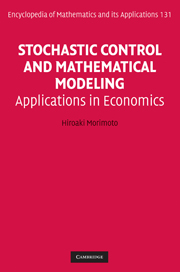Book contents
- Frontmatter
- Contents
- Preface
- Part I Stochastic Calculus and Optimal Control Theory
- Part II Applications to Mathematical Models in Economics
- 6 Production Planning and Inventory
- 7 Optimal Consumption/Investment Models
- 8 Optimal Exploitation of Renewable Resources
- 9 Optimal Consumption Models in Economic Growth
- 10 Optimal Pollution Control with Long-Run Average Criteria
- 11 Optimal Stopping Problems
- 12 Investment and Exit Decisions
- Part III Appendices
- Bibliography
- Index
10 - Optimal Pollution Control with Long-Run Average Criteria
from Part II - Applications to Mathematical Models in Economics
Published online by Cambridge University Press: 07 September 2011
- Frontmatter
- Contents
- Preface
- Part I Stochastic Calculus and Optimal Control Theory
- Part II Applications to Mathematical Models in Economics
- 6 Production Planning and Inventory
- 7 Optimal Consumption/Investment Models
- 8 Optimal Exploitation of Renewable Resources
- 9 Optimal Consumption Models in Economic Growth
- 10 Optimal Pollution Control with Long-Run Average Criteria
- 11 Optimal Stopping Problems
- 12 Investment and Exit Decisions
- Part III Appendices
- Bibliography
- Index
Summary
In this chapter, we study the theory of optimal pollution management in environmental economics. We consider a society consuming some good, which generates pollution as a byproduct of this consumption.
The pollution stock X(t) is only gradually degraded, and its growth rate incorporates a random shock with mean of zero and constant standard deviation r. The social welfare is defined by the utility U(c) of the consumption c net of the disutility D(x) of pollution x. The objective of the social planner is to choose time paths for consumption to maximize the social welfare with long-run average criteria.
By using the vanishing discount technique, we solve the HJB equation (10.6) associated with the long-run average problem as the limit equation when the discount rate β converges to zero. The optimal consumption policy is shown to exist in a feedback form, and the maximum value is independent of the initial condition X(0) > 0.
The Model
Consider a society consuming a homogeneous good and accumlating pollution. Define the following quantities:
X(t) = stock of pollution at time t.
r = the constant rate of pollution decay, r > 0.
L = the upper bound of the maximum flow of pollusion, L > 0.
c(t) = flow of pollution (or consumption) at time t.
B(t) = the standard Brownian motion.
σ = the nonzero diffusion constant. […]
Information
- Type
- Chapter
- Information
- Stochastic Control and Mathematical ModelingApplications in Economics, pp. 237 - 251Publisher: Cambridge University PressPrint publication year: 2010
